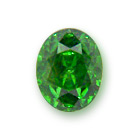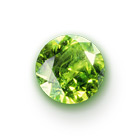Demantoid Garnet from Russia
The demantoid is one of the most brilliant gemstones that exist, yet until recently it was little known except among collectors and gemstone lovers. Strictly speaking it is a green garnet, or rather the star of the green garnets. Not without reason does it bear a name which means 'diamond-like'. The name comes from the Dutch and makes reference to the outstanding quality of this gem, its incomparable brilliance and fire. Some gemstone lovers claim that a demantoid will continue to glow even in the shade.
The demantoid belongs to the large gemstone family of the garnets, and is actually a variety of the garnet mineral andradite. But it is more than that: it is the most expensive kind of garnet and one of the most precious of all gemstones. It is highly esteemed on account of its rarity coupled with that incredible luminosity.
The demantoid belongs to the large gemstone family of the garnets, and is actually a variety of the garnet mineral andradite. But it is more than that: it is the most expensive kind of garnet and one of the most precious of all gemstones. It is highly esteemed on account of its rarity coupled with that incredible luminosity.
For the latter, at least, there is a plausible explanation: the demantoid has an extremely high refraction (refractive index 1.880 to 1.889). Yet its high dispersion is also remarkable, in other words its ability to split the light which comes in through the facets and break it down into all the colors of the rainbow. The demantoid is a master of this, and does it even better than the diamond.
The spectrum of its colors includes many shades of green, from a slightly yellowish green to a brownish green with a golden glow. Particularly precious is a deep emerald green, though this only occurs very rarely indeed. It is not only fine and unusual, but the specimens are also mostly small, large ones being extremely rare. Once cut, only a few stones weigh more than two carats, and most of them hardly exceed one. And even if you come across one set in a piece of jewellery, it is always likely to be a small stone.
The spectrum of its colors includes many shades of green, from a slightly yellowish green to a brownish green with a golden glow. Particularly precious is a deep emerald green, though this only occurs very rarely indeed. It is not only fine and unusual, but the specimens are also mostly small, large ones being extremely rare. Once cut, only a few stones weigh more than two carats, and most of them hardly exceed one. And even if you come across one set in a piece of jewellery, it is always likely to be a small stone.
Favourite stone of Russia's star jeweller
There have been a good many beautiful gems which appeared like shooting-stars in the fascinating world of gemstones and vanished from the scene again after only a short time. That indeed is probably what would have happened to the demantoid ... if a goatherd had not happened to be going about his business one day in Namibia. But more of that in a moment.
After its discovery in 1868 in Russia's Ural mountains, the demantoid rapidly proceeded to become a much desired gemstone. Comet-like, it scintillated among the finest jeweller's workshops in Paris, New York and St. Petersburg. First and foremost, Russia's star jeweller Carl Fabergé adored it for its tremendous brilliance and loved to incorporate it in his precious objects.
But with the chaos of the First World War, the green star began to fade rapidly. Now, it made only rare appearances in the gemstone trade, and when it did so it was mostly incorporated in an item of second-hand jewelery, or among remnant stocks from the places where it had originally been found in the Urals. Occasionally Demantoids were found in other parts of the world, for example in the Congo, or in Korea in 1975, but the quality of these stones was such that they were suitable for collectors' use only.The situation changed quite suddenly in the middle of the 1990s, when a new seam bearing gemstones was discovered in Namibia. Demantoid was among them.
The story of that discovery reads like a thriller. It is set in the southern Damara country near the Spitzkoppe, as the 'Matterhorn of Africa' is also known. The vast, steppe-like country surrenders to the scorching African sun. Far away on the horizon, the 'black mountains' lie blurred in the bluish haze. It's a dry, hard country.
The story of that discovery reads like a thriller. It is set in the southern Damara country near the Spitzkoppe, as the 'Matterhorn of Africa' is also known. The vast, steppe-like country surrenders to the scorching African sun. Far away on the horizon, the 'black mountains' lie blurred in the bluish haze. It's a dry, hard country.
Yet for a long, long time it had held an unknown treasure: gemstones! Millions of years before, liquid magma had shot up from the bowels of the Earth and solidified shortly before it reached the surface. In the course of time, the wind and the elements removed the surface strata until finally only the distinctive granite mountain, the Spitzkoppe, was left. And the gemstones, that is.
No-one had an inkling of their existence until in December 1996, quite by chance, a wandering goatherd found a number of crystal-like objects which seemed to him worthy of attention. When he had shown them around a bit in a nearby village, the attention of experts was drawn to the find, and they quickly realized what a treasure was being presented to them.
Meanwhile, the Namibian government has issued concessions for gemstone mines. The rare gemstones are carefully quarried by hand from the parent rock. Care is taken to ensure that as little as possible of the precious raw material is lost.
Meanwhile, the Namibian government has issued concessions for gemstone mines. The rare gemstones are carefully quarried by hand from the parent rock. Care is taken to ensure that as little as possible of the precious raw material is lost.
Why the horsetail influences the value of a demantoid
Demantoids from Namibia come in shades from a vivacious light green to an intense blue-green. They have a striking brilliance. Thanks to their hardness of just under 7 on the Mohs scale, they are well suited to being used in jewelery. However, they do lack one feature by which the true demantoid had always been able to be identified through the microscope: 'horsetail inclusions'.
Demantoids from Namibia come in shades from a vivacious light green to an intense blue-green. They have a striking brilliance. Thanks to their hardness of just under 7 on the Mohs scale, they are well suited to being used in jewelery. However, they do lack one feature by which the true demantoid had always been able to be identified through the microscope: 'horsetail inclusions'.
These golden brown crystal threads of chrysotile, mostly appearing to radiate out from the centre of the stone, had previously occurred in almost all Demantoids. But - more's the pity - they were missing in the relatively inclusion-free gems from Namibia. These horsetail inclusions were not only typical of the demantoid; they could even increase its value if they were pronounced. That may sound surprising, since as a rule inclusions, which can impair the transparency of a gemstone, are not a welcome sight.
But with the Demantoids 'horsetail inclusions' it is a different matter. A beautiful, well formed inclusion can increase the value of the gemstone considerably, a good many collectors being prepared to pay a higher price.
If you are offered a demantoid, it is definitely a good idea to have a look at it through the gemstone microscope. If the stone comes from Russia, you may be able to see these fine, fibrous wisps whose resemblance to the tail of a horse is unmistakable. If that is the case, you have a definite pointer to its origin.
If you are offered a demantoid, it is definitely a good idea to have a look at it through the gemstone microscope. If the stone comes from Russia, you may be able to see these fine, fibrous wisps whose resemblance to the tail of a horse is unmistakable. If that is the case, you have a definite pointer to its origin.
At the same time, this 'fingerprint of Nature' shows you that you are holding one of the rarest and most valuable gemstones in your hand. This rarity will also make itself felt in the price, since a demantoid from Russia will be valued much more highly than a green garnet from Namibia, however brilliant the latter may be.
When you are ready to purchase one of the jewels of the gem world, please contact us at gems4u@rocketmail.com
Have a good day and a good new years
Gregg

